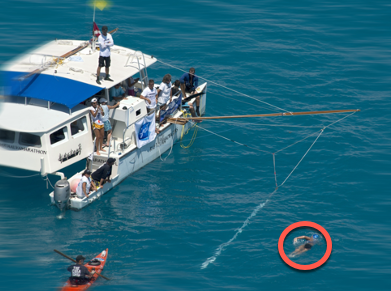Intro
In August of 2013, just days after her 64th birthday, Diana Nyad became the first person to swim from Cuba to Florida without a shark cage. The picture below shows her (in the red circle) beside her support boat. The 110-mile swim was her fifth attempt at the crossing since 2011. The previous attempts had failed due to weather, currents, and jellyfish stings. On September 2, 2013 she finally came ashore (see photo further below) at Key West after 52 hours, 53 minutes of swimming interrupted only by treading water to take on food and fluids.


An amazing accomplishment!
Part 5 Senior Athletes Today
My, how things have changed in the last 50 years. When I was young the thought that a person in their 60s or 70s – let alone in their 80s – would compete in events such as triathlon, marathon running, ultra-bike rides, ski mountaineering, and weightlifting was unheard of. At those ages we were used to people either being dead, on the verge of death, or, at the very most, playing card games with friends on Friday nights. Back then, old folks became spectators in life and were mostly confined to wheelchairs and walkers. As we reasoned back then, no one in their right mind would be physically active when they were that old. It was dangerous. You could die if you walked briskly around the block. In fact, it used to be that one of the most important things a doctor would tell you during an office visit is that you need to take it easy and rest a lot when you’re that old. Don’t take any risks by exercising.
All of this changed with the Baby Boomers – those born between 1946 and 1964. These folks now range from their late 50s to late 70s. The world has never seen a generation like this before. It’s bizarre.
But, of course, you must realize that this isn’t happening because somehow the human body has gone through a physiological change. It’s happening because most of the Boomers have never been content to accept inactivity and impending death, as their parents did. The Boomers came of age with Frank Shorter’s Olympic medals and the running boom of the 1970s, the growth of triathlon in the 1980s following the first Ironman in 1978, Greg LeMond and bike racing in the 1980s, and many other role models in a wide variety of endurance sports that showed the value of exercise not only for health but also for fun. The world is indeed different now than the way my parents saw it.
In fact, my parents never fully accepted that I was doing this stuff largely for fun. There was surely something wrong with me. Nor could they understand what I did for a living – coaching people who wanted to also press their physical limits. I vividly recall my mom asking what I actually did as a coach. So I gave her an example. I told her that I had clients who wanted me to prepare them for different types of events, like running a marathon. To help her understand that I told her that I may tell an athlete to run 10 miles on Saturday. “And they pay you for that?” she asked somewhat incredulously. She always seemed to think I must be destitute because I surely couldn’t make a living telling people to do such stupid things. On the other hand, my brother was a heating and air conditioning technician. She fully understood what he did and therefore, she concluded, he was doing much better than me. I never tried to argue the point with her. She passed away in 2009 probably still believing right up to her last days that I was a complete failure in life.
Boomers are strange in many ways relative to the ways their parents saw the world. Today’s old fogies believe that there really isn’t anything they can’t do. If they put their minds and muscle to it they can still perform at a relatively high level, certainly by comparison with previous generations. The key is motivation. But the Boomers also have to learn what kind of events they are best at. In your 60s and 70s you are probably much better at long, relatively slow endurance events rather than short, fast sprints. With aging we lose fast twitch muscle at a faster rate than slow twitch fibers. But we’ve still got big hearts, in more ways than one.
I’ve been featuring senior and super-senior athletes on the intro to my blogs the last two weeks. There are more to come, including others with athletic performances most 20-year-olds would find very challenging. And because of this way of seeing our lifestyle, we are likely to be around a lot longer and still be active right up until our last days.
Keep having fun!

You must be logged in to post a comment.